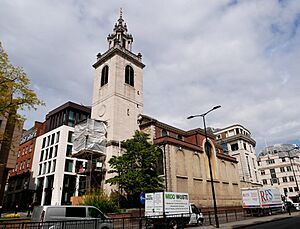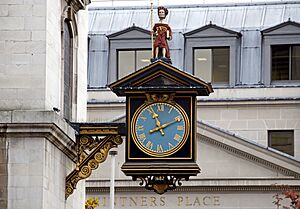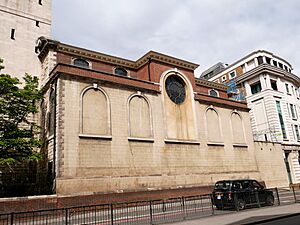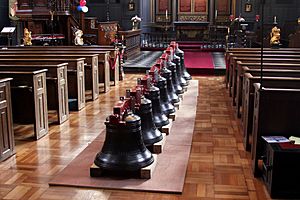St James Garlickhythe facts for kids
Quick facts for kids St James Garlickhythe |
|
|---|---|
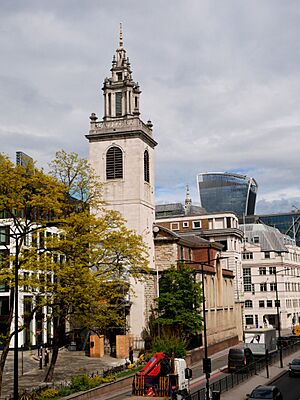
St James Garlickhythe from the southwest
|
|
| Location | City of London |
| Country | England |
| Denomination | Church of England |
| Previous denomination | Roman Catholicism |
| Churchmanship | Prayer Book Catholic |
| Website | |
| Architecture | |
| Heritage designation | Grade I listed building |
| Architect(s) | Sir Christopher Wren |
| Style | Baroque |
| Specifications | |
| Bells | 8 Royal Jubilee + 2 quarter and 1 hour |
| Administration | |
| Diocese | Diocese of London |
St James Garlickhythe is a Church of England church in the City of London. People sometimes call it "Wren's lantern" because it has so many windows!
This church has been around since the 1100s. But a big fire, called the Great Fire of London, destroyed it in 1666. It was then rebuilt by the famous architect Sir Christopher Wren and his team. St James Garlickhythe is also the official church for several old London trade groups called livery companies.
Contents
History of St James Garlickhythe
The church is named after St James the Great, one of Jesus's disciples. St James Garlickhythe is a stop on a special journey for pilgrims. This journey ends at a big church in Santiago da Compostela, Spain. Visitors to the London church can get their pilgrim passport stamped with a scallop shell design.
The name "Garlickhythe" comes from a nearby landing spot, or "hythe." In the Middle Ages, garlic was sold there.
The church was first mentioned in a will from the 1100s. It was also known by other names, like St James in the Vintry or St James-by-the-Thames.
Ships from France that brought garlic also carried wine. So, St James Garlickhythe has a long connection with wine merchants. The church is in an area of London called Vintry. In 1326, a London official and wine merchant named Richard de Rothing paid to have the church rebuilt. Another group linked to the church is the Joiners' Company. They started as a religious group at St James in 1375.
In the 14th century, the church became a "collegiate" church. This meant it had seven priests who held special services. St James was very important in the Middle Ages. Six Lord Mayors of London were buried there.
St James became a regular parish church when King Henry VIII closed many monasteries. The church actually benefited from this change. In 1560, parts of a nearby church were used to make new pews for St James. The choir also received new song books.
King Henry VIII also ordered all churches to keep records of births, deaths, and marriages every week. The oldest records still existing are from St James. The first entry is a baptism from November 18, 1535.
The church was repaired and made bigger several times in the early 1600s. The north side was rebuilt in 1624, and a gallery was added in 1644.
During the time of the Commonwealth of England, the church's leader was removed in 1647. This was because he used the Book of Common Prayer, which was not allowed then. But the church members still paid him a pension.
Rebuilding After the Great Fire
The Great Fire of London in 1666 destroyed the church completely. Rebuilding started ten years later. Old records in the church porch say:
"The foundation thereof were laid AD 1676 – John Hinde and John Hoyle, Church Wardens. It was rebuilt and re-opened 1682 and completely finished AD 1683…"
The main part of the church was finished, but the tower still needed its top part, called a steeple.
Church records from 1682 show payments for things like:
- Wine for the church opening.
- Cushions for people to sit on.
- More wine when the Lord Mayor visited.
- Money paid to Wren's clerks to encourage them to finish the steeple quickly.
But this encouragement didn't work right away. Building on the tower didn't start until 33 years later. It was finally finished in 1717 by Nicholas Hawksmoor. The total cost for the church and tower was £7230.
In 1711, a writer named Richard Steele visited St James for a Sunday service. He wrote about the rector's powerful speech in his newspaper, The Spectator. He praised the rector's way of speaking.
One month after this sermon, a famous composer named William Boyce was baptized at St James Garlickhythe.
In the late 1800s, many people moved out of the City of London to the suburbs. This left many city churches with very few people attending. In 1860, Charles Dickens visited St James Garlickhythe. He wrote about it in his book The Uncommercial Traveller. He described a small group of twenty people and a church that felt damp and dusty.
A law called the Union of Benefices Act 1860 allowed old city churches to be torn down. Their land could then be sold to build new churches in the suburbs. Several churches nearby were destroyed, but St James was saved. This might have been because of its strong connections to the old trade guilds.
During World War I, a bomb from a Zeppelin airship missed the church. To show thanks, the church started an annual "Bomb Sermon."
World War II and Restoration
In May 1941, during the London Blitz (heavy bombing during World War II), a large German bomb crashed through the roof of St James. It buried itself under the floor but did not explode. It was later removed and safely detonated elsewhere. Buildings around St James were destroyed by fire bombs. This caused a lot of damage to the church's outside, including its clock.
While repairs were happening in 1953, workers found that the wooden parts of the church were infested with death watch beetles. The church had to close until 1963 for a big restoration project. Many people said it was the best restoration of a City church.
In 1991, during construction nearby, a crane collapsed. Its arm crashed into the south wall of the church. This caused the church to close again while the wall was rebuilt and some furnishings were replaced.
St James Garlickhythe Today
The church's full name today is The Parish Church of St James Garlickhythe with St Michael Queenhythe and Holy Trinity the Less.
The church's area covers seven older parishes that existed before the Great Fire. It is also responsible for services at the nearby St Michael Paternoster Royal church.
Sunday and daily services at St James use the 1662 Book of Common Prayer. It is the church for more than a dozen livery companies, including the Clockmakers, Dyers, and Vintners. It is also the church for the Intelligence Corps.
The church does not allow female priests or bishops to lead services. It receives special guidance from the Bishop of Fulham.
The Church Building
St James Garlickhythe is shaped like a rectangle. The tower is on the west side, and a special part called the chancel sticks out from the east. It is built from brick and stone. The main entrance is through a doorway in the tower.
The south side of the church, which faces Upper Thames Street, used to be hidden by other buildings. It only became the main front of the church after 1971. It has five sections with arched windows.
The 125-foot tower was originally covered in plaster. This plaster was removed in 1897. After World War II, the tower was covered with a special stone called Portland stone. The clock on the west side, which shows an image of St James, is a copy from 1988 of the original 1682 clock.
The tower is plain until you reach the spire. The stone spire was designed by Nicholas Hawksmoor. It looks similar to spires on other churches by Wren. It has three levels, getting smaller as it goes up. At the very top is a flag.
The gates on the west side, with their vine leaf and grape designs, were a gift from the Vintners' Company.
The church was named a Grade I listed building in 1950. This means it is a very important historical building.
Inside the Church
The inside of St James Garlickhythe is 40 feet high, making it the tallest of all Wren's churches. Because it was originally surrounded by other buildings, Wren designed very tall windows to let in light.
The church has a main area called a nave and two narrow side aisles. There are two rows of five Ionic columns running from west to east. These columns support a decorative beam.
The church was updated a lot in the 1800s. However, many of these Victorian changes, like the stained glass windows, were removed after World War II.
To the east is the chancel, which has a rounded ceiling. To the west is a gallery, built in 1714. It holds the original organ from 1719, which is decorated with cherubs and palm trees.
The beautiful crystal chandelier was a gift from the Glass Sellers' Company. It is a copy of one that was destroyed in the 1991 crane accident.
The reredos (a screen behind the altar) is original. It has columns and shows the Ten Commandments. The communion table and the communion rail are also original. The font, used for baptisms, was made by the church's stonemason, Christopher Kempster.
In 1876, St James's parish joined with that of St Michael Queenhithe, another nearby Wren church. St James received many furnishings from St Michael's. These include the pulpit, a special stand for the preacher, and a wig peg. Two royal coats of arms are also on display. One is from the House of Stuart and the other from the House of Hanover. This makes St James Garlickhythe the only church in the City of London with two royal arms reliefs.
A well-preserved mummy of a man, known as "Jimmy Garlick," used to be on display. His body was found in the church vaults in 1855. For a while, it was thought he was a teenager who died around 1700. The body was once in a glass cabinet for people to see.
In 2004, Jimmy Garlick was featured in a TV show called Mummy Autopsy. Scientists used modern methods to study him. They found he died between 1641 and 1801. They also discovered he had osteoarthritis, a condition that affects older people. The mummy appeared to be balding and had tooth decay, which also suggested he was older. The body is now buried in a special stone coffin in the church crypt and is no longer on public display.
Church Bells
A new set of eight bells, called "The Royal Jubilee Bells," were made in 2012. They were first placed on a boat and rung on the River Thames during the Diamond Jubilee celebrations for Queen Elizabeth II. After that, they were permanently installed in the church tower.
Notable Burials
- Richard Platt, a brewer and alderman, buried in 1600.
- George Stanley, 9th Baron Strange
See also


